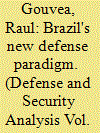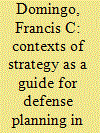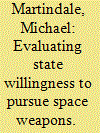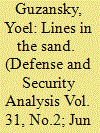|
|
|
Sort Order |
|
|
|
Items / Page
|
|
|
|
|
|
|
| Srl | Item |
| 1 |
ID:
140550


|
|
|
|
|
| Summary/Abstract |
In 2015, Brazil has taken steps toward re-consolidating its domestic defense industry. In the 1980s, Brazil built a dynamic and diversified defense industry. The state-driven effort resulted in a tripod strategy, where the state, state-run companies, and their private sector became the pillars of Brazil's defense industry. Brazil developed an export-driven defense industry; where close to 80–90% of its output was exported to Latin American, African, Arab, and Asian nations. In the 1980s, Brazil became the world's fifth largest exporter of defense products and services, exporting to over 40 countries. In the 1990s and 2000s, Brazil's defense industry suffered a dramatic reduction in size, diversification, and momentum. Successions of domestic political and economic policies have relegated Brazil's once emerging defense industry to a marginal position in the global defense industry. This article analyzes future prospects, challenges, and growth strategies for Brazil's defense industry.
|
|
|
|
|
|
|
|
|
|
|
|
|
|
|
|
| 2 |
ID:
140553


|
|
|
|
|
| Summary/Abstract |
Efforts toward developing an independent and credible Philippine defense policy were revived when Benigno Simeon C. Aquino III was elected President of the Philippines in 2010. President Aquino renewed the military modernization program in 2012 and emphasized the necessity of a “minimum credible defense posture.” Given the modernization efforts of the government, this article aims to contribute to the development of the concept of minimum credible defense posture by exploring how theory contributes to defense planning. It argues that the contexts of strategy are useful in planning for national defense because these contexts can provide a conceptual framework for defense planners. It proceeds in three parts: the opening section reviews the literature on defense planning; the second surveys the context of developing strategies as discussed in the General Theory of Strategy; and the last provides a definition of minimum credible defense and applies the context of developing strategies to the case of the Philippines.
|
|
|
|
|
|
|
|
|
|
|
|
|
|
|
|
| 3 |
ID:
140546


|
|
|
|
|
| Summary/Abstract |
Many studies exist which evaluate the domain of space from a political perspective in order to advocate for a certain position regarding what states ought to do or not do in space. Few studies exist which address how states actually behave with regard to outer space. In an attempt to fill this gap in the literature, the present study evaluates the determinants of state space behavior. The results identify a blend of the realist pursuit of power and liberal normative restrains acting on state space behavior.
|
|
|
|
|
|
|
|
|
|
|
|
|
|
|
|
| 4 |
ID:
140541


|
|
|
|
|
| Summary/Abstract |
This article explores series of “red lines” issued over the years by the USA and Israel toward Iran and Syria. It argues that the effectiveness of inflexible “red lines” in an environment that is given to rapid change is doubtful. They provide an adversary with the ability to determine when the deterring party will act and when they will not, a situation that is often undesirable. Moreover, their inflexible nature on the one hand opens the doors for circumvention while technically staying within their parameters. On the other hand, a strategy of more ambiguous “red lines” that allow flexibility in choosing the time, intensity, and nature of the response could also achieve a considerable deterrent effect, provided that they do not remain mere bluffs.
|
|
|
|
|
|
|
|
|
|
|
|
|
|
|
|
| 5 |
ID:
140552


|
|
|
|
|
| Summary/Abstract |
The USA is currently facing an increasingly diverse range of threats, including non-state actors, particularly violent extremist organizations attempting to do harm. The national leadership has made it clear that for the near future it will employ Special Operations Forces (SOF) as the tool of choice in short-duration, high-intensity operations that have more in common with the battle of Takur Ghar, than those with a larger footprint. It is critical then that the lessons of the past are learnt now and are applied before employing SOF in the future. This becomes especially important given the short lead-time in concert with the short-duration/high-intensity tempo of their operations. In the Battle of Takur Ghar, during Operation Anaconda, rigid adherence to the joint functions, especially clearer and more robust Command and Control (C2) and Intelligence, Surveillance, and Reconnaissance (ISR) in the planning and execution of Operation Anaconda would have yielded a better operational outcome and saved lives. With the benefit of hindsight, many things could have been done differently, but several key issues stand out. The C2 structure must include all components from the outset to synchronize effects and rapidly re-task ISR. There must be multiple communications redundancies and adequate bandwidth. Finally, all SOF, conventional and interagency capabilities must be synchronized under one task force commander with a sufficiently robust C2 infrastructure to direct the entire effort. As our nation calls on SOF at an ever-increasing rate, we must take those lessons learned and apply them to future operations.
|
|
|
|
|
|
|
|
|
|
|
|
|
|
|
|
| 6 |
ID:
140545


|
|
|
|
|
| Summary/Abstract |
The Ground-based Midcourse Defense system is intended to protect the US homeland against limited attacks from intermediate- and long-range ballistic missiles. It has succeeded in intercepting target missiles and can engage a threat launched from North Korea or the Middle East, targeting any point in the USA. Nevertheless, high-profile struggles and program changes related to homeland ballistic missile defense (BMD) continue to make headlines. The most significant struggle has been a string of three straight intercept test failures over five years, followed by the recent successful intercept test in June 2014. This article first briefly reviews the current threats of concern. It then examines homeland BMD policy objectives, followed by the current major technical issues in supporting these objectives and, then, the likelihood of negating a warhead. Finally, it highlights major considerations that should be part of the trajectory the US government takes moving forward.
|
|
|
|
|
|
|
|
|
|
|
|
|
|
|
|
| 7 |
ID:
140549


|
|
|
|
|
| Summary/Abstract |
Islamist extremism as an ideology has seemingly spread in influence in the past few years. The violent Islamist threat may have a singular religious dogma, but that does not mean that it will interact in the same fashion within the various cultures it infests. The Sub-Saharan region is one general context where Islamist extremism is both vividly active and misunderstood. Africa's reaction to: Arabization; the adjustment to post-colonial rule; the perception of secular government institutions; the extent of cultural and religious pluralism; and the local character of Muslim leadership and institutions are all very different from that of the Middle East. Scores of terrorism analysts and even Arab populations only too familiar with the Middle East context superimpose Middle East threats over the Sub-Saharan African cultural landscape. Instead of generalizing the Islamist threats, it might be better to ask why it is that violent Islamist groups have traditionally been challenged to expand their influence in Muslim Sub-Saharan Africa. The underestimated Islamist is using ignorance to its advantage, recruiting through channels unnoticed by its Arab counterparts while creatively catering its message by region.
|
|
|
|
|
|
|
|
|
|
|
|
|
|
|
|
|
|
|
|
|